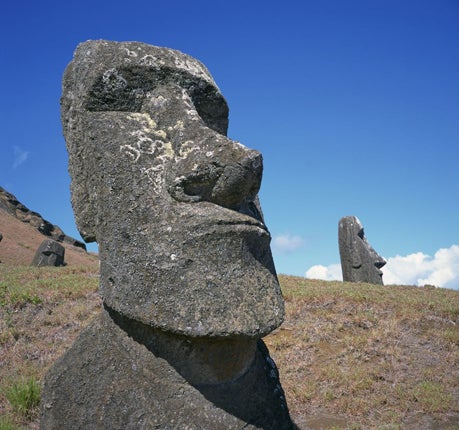Secret to a longer life lies on Easter Island
Scientists have found an anti-ageing drug that works on mice – and could do the same for humans

A drug originating on Easter Island, the mysterious South Pacific home of a lost statue-building people, may become the first substance to slow down human ageing, new research indicates.
Rapamycin, a pharmacological product used to prevent rejection in organ transplants, has been found to extend the lifespan of mice by up to 38 per cent, raising the possibility that it may delay ageing in people.
Hitherto a matter for science fiction, the idea of an anti-ageing drug which would allow people to prolong their natural lifespan and also to avoid age-related diseases is now being seriously considered for the first time as a result of the findings by American researchers.
Rapamycin is a bacterial product originally found in a soil sample from Easter Island, the Polynesian extinct volcano famous for its monumental statues erected hundreds of years ago by the island people, and known in the region as Rapa Nui – hence the drug's name. Originally developed as an anti-fungal agent, rapamycin was soon found to have powerful immuno-suppressant properties and thus be valuable for preventing rejection of transplanted organs. It was also found to delay the ageing process when used experimentally with three sets of lower organisms: yeast, nematode worms and fruit flies.
Now, however, it has been shown to affect the ageing of mice – the first time that this has ever been shown with a mammal.
A team of 14 researchers from three institutions, led by David Harrison from the Jackson Laboratory at Bar Harbor in Maine, fed rapamycin to mice late in their life – at 600 days of age – and showed that both the median and maximal lifespan of treated animals were considerably extended. Currently, the only way to extend the life of a rodent is by severely restricting its diet, so this marks the first report of a pharmacological intervention that lengthens the life of mammals – with clear implications for humans.
The results, published today in an online paper on the website of the journal Nature, are attracting considerable excitement, and an accompanying article in Nature by two of the world's leading experts on the ageing process, Matt Kaeberlein and Brian K Kennedy from the University of Washington, Seattle, headed "A Midlife Longevity Drug?" openly asks the question: "Is this the first step towards an anti-ageing drug for people?"
Their answer is that it may well be. Dr Kaeberlein and Dr Kennedy first issued a warning to people not to start taking rapamycin at once in the hope of prolonging their lives – "the potential immuno-suppressive effects of this compound alone are sufficient to caution against this," they advised.
But they added: "On the basis of animal models, however, it is interesting to consider that rapamycin ... might prove useful in combating many age-associated disorders. Also ... it may be possible to develop pharmacological strategies that provide the health and longevity benefits without unwanted side-effects.
"So, although extending human lifespan with a pill remains the purview of science fiction writers for now, the results of Harrison et al provide a reason for optimism that even during middle age, there's still time to change the road you're on."
Rapamycin was known to have an influence on ageing in the lower organisms by disrupting the influence of an enzyme known as TOR, which regulates cell growth. Dr Harrison and colleagues found that this was also the case with mice, and found that rapamycin feeding could extend mouse lifespan even when started late in life.
The maximum lifespan went up from 1,094 days to 1,245 days for female mice, and from 1,078 to 1,179 for male mice – a striking increase of life expectancy of 38 per cent for females and 28 per cent for males.
Dr Harrison and his colleagues conclude: "An effective anti-ageing intervention that could be initiated later than the midpoint of the lifespan could prove to be especially relevant to clinical situations, in which the efficacy of anti-ageing interventions would be particularly difficult to test in younger volunteers. Our data justify special attention to the role of the TOR pathway in control of ageing in mammals and in the pathogenesis of late-life illnesses."
Also known as sirolimus, rapamycin was first discovered as a product of the bacterium Streptomyces hygroscopicus, which was found in an Easter Island soil sample.
Probably the world's most remote and least-visited inhabited island, Easter Island is globally famous for its haunting monumental stone statues of human faces, set up around the coast, known as Moai. Weighing as much as 80 tonnes, they were carved by a lost people, whose society may have collapsed, according to the American environmental geographer Jared Diamond, when they overexploited their forests. Volcanic, hilly and now treeless, and a territory of Chile, the island is situated 2,180 miles west of Chile itself and 1,290 miles east of Pitcairn Island; its European name comes from its discovery on Easter Sunday 1722, by the Dutch explorer Jacob Roggeveen. Its oldest known Polynesian name is thought to be Te Pito O Te Henua, meaning "the navel of the world". Rapa Nui is a name given to it by Tahitian sailors in the 19th century.
Join our commenting forum
Join thought-provoking conversations, follow other Independent readers and see their replies
Comments